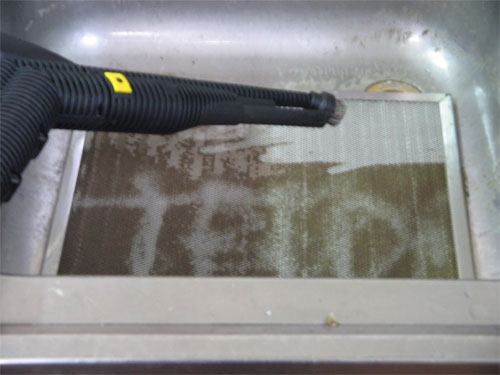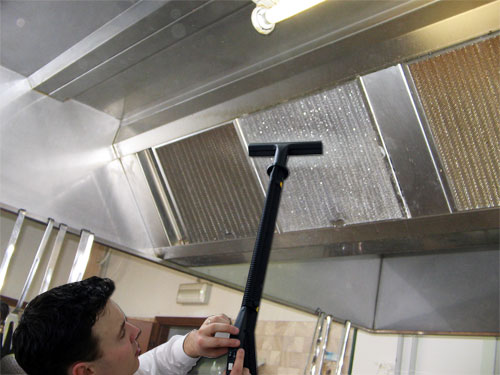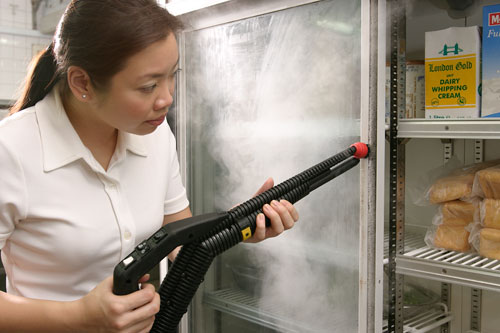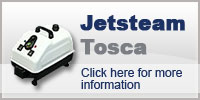How to Make Commercial or Domestic Kitchen fully Steam Sanitised
Kitchen cleaning is a time consuming and messy task that very few people would enjoy completing. This is because kitchen surfaces are usually left quite greasy after cooking with oil, fat and food residues. With the importance of food safety, keeping kitchen surfaces clean is vital. Traditionally kitchens have been cleaned by the use of scrubbing, chemical degreasers and disinfectant sprays.
At Tecnovap we supply a range of steam cleaning systems that are ideal for fast hygienic cleaning and degreasing of all types of kitchen surfaces. Steam is great as the high temperatures melt grease fast and thermally sanitise surfaces on contact. Tecnovap steamers are especially popular for degreasing canopies or ovens, detailing stoves, sanitising benches and cool rooms.
For information on how Tecnovap superheated dry steam cleaners work on different kitchen surfaces read below:
How to Clean Commercial Ovens
Commercial and domestic ovens should be cleaned on a regular basis to help keep them grease and odour free. This is especially the case for commercial ovens given the size and more frequent use compared with domestic ovens. If cleaned regularly the oven cleaning time will be dramatically reduced compared to periodic cleaning when hard to remove fatty grime builds up and stubborn stains bake on.
Traditionally ovens have been cleaned with manual scrubbing by hand and harsh oven degreasers. This method though has been messy, time consuming and known to leave nasty chemical smells in ovens that can last for weeks or transfer to food. Thankfully there are now far easier methods to clean ovens including Tecnovap dry steam cleaning equipment that reduce cleaning time, effort and eliminate use of degreasers.
Ideal Tecnovap Cleaning Products for Ovens
Jetvac steam vacuums (Eco, Junior, Pro, Maxi) or JetSteam steam cleaners (Tosca, Pro, Maxi) are ideal for cleaning ovens as +155ºC superheated 94% dry steam melts grease, oils and fats without producing much excess residue. Once emulsified the melted grime is easily wiped away with a cloth. This process increases efficiency, eliminates the need for degreasers, prevents chemical odours and reduces manual scrubbing.
Using the power of steam to clean commercial ovens is a wise choice as you wouldn't want valuable customers tasting chemical residue in their food.
How to Clean Ovens with a Jetsteam / Jetvac
The first step when cleaning ovens to remove any racks. This will enable easy cleaning of the oven ceiling, walls and floors. If the racks are heavily soiled it can also be a good idea to soak them in a tub of degreaser. From here you will need to identify the state of the oven, heavy or lightly soiled, to determine the best method to clean.

Heavily Soiled - For heavily soiled greasy ovens it is best to use the 'Steam Lance' with a 'nylon brush' and a cloth/paper towel. Start inside the oven from the ceiling steaming in small areas to melt the grease and then wipe away with the cloth. Repeat this process from top to bottom until the oven is cleaned. The same tool and process can also be used on the oven door. For very stubborn baked on grime try a stiffer brass brush or steel wool can be used providing it does not scratch the surface.
The oven racks can also be detail cleaned using the 'Steam Lance' with either a 'Steel Detailing Brush' or 'Steel Wool Ball' in the 'Round Nylon Brush'.

Lightly Soiled - For lightly soiled duco cleaning can be done using either the 'Steam Lance' with a cloth to dry, or using 'Triangle Swivel' tool with a cloth to steam and remove grease. With the Steam Lance spray near close contact and wipe dry. With the Triangle Swivel wrapped in a cloth tool clean on contact. It is always best to start high (oven ceiling) and work down (over floor) as moisture/grime will fall.
How to Clean Canopies
Canopies and filters should be cleaned on a regular basis to help keep them grease free and functioning properly. This is especially the case in commercial kitchens like restaurants, cafes and take away outlets where regular canopy cleaning must be conducted for insurance purposes. Canopies and filters in fish n' chip shops are especially bad given that amount of oil residue they extract from the air.
Traditionally canopies have been cleaned with a man on a ladder, spraying hazardous chemicals and scrubbing by hand. This is simply not an effective or OH&S friendly method. We recommend cleaning canopies safely from the ground with high temperature dry steam.
Ideal Tecnovap Cleaning Products for Canopies
Jetvac steam vacuums (Eco, Junior, Pro, Maxi) are ideal for cleaning canopies as +155ºC superheated 94% dry steam melts grease, oils and fats without producing much excess residue. Once emulsified the residue is simply removed simultaneously by vacuum. This process increases efficiency, eliminates the need for degreasers, prevents residue falling to floor, reduces manual scrubbing and does not require the use of ladders. The Jetsteam (Tosca, Pro, Maxi) steam only machines can also be used but are slightly less effective without vacuum extraction. Instead a cloth must be used to remove oils.
How to Clean Canopies with a Jetsteam / Jetvac
The method of cleaning canopies will depend on whether a Jetsteam steam cleaner or Jetvac steam vacuum is being used. The level of grease and oil present on the surface will also have a bearing.

Jetvac Steam Vacuum - With a Jetvac steam vacuum canopies can either be cleaned using the steam vacuum floor tool or a window/bench tool. To clean:
- Heavily soiled greasy canopies operate in small areas starting from the top. Firstly use steam only to melt the grease and then turn on the vacuum to extract; leaving the surface clean, degreased and dry. Repeat this process working down the canopy.
- Lightly soiled canopies start at the top simultaneously steaming and vacuuming the surface. This will melt and extract soiling in a single pass leaving the surface dry.
Jetsteam Steam Cleaner - With a Jetsteam steam cleaner canopies can either be cleaned using the Triangle Swivel or Rectangular Floor tool with a cloth. To clean:

- Heavily soiled greasy canopies use the tools with exposed bristles to steam and scrub. Work in small areas starting from the top to melt grease and immediately wipe away with a cloth. This can be done with the steam hose in one hand and a cloth in the other depending on the height of the canopy. Repeat this process down the canopy and change cloths when too heavily soiled.
-Lightly soiled canopies start at the top with a cloth wrapped around the chosen tool and steam down on contact. The heat of the steam will melt the greasy oils and the cloth will collect the emulsified grime. It is always best to start high then work down as moisture/grime will fall and the bottom is usually more heavily soiled.
How to Clean Fridges
Commercial and domestic fridges should be cleaned on a regular basis to help keep them hygienically and odour free. This is especially the case in large commercial fridges or cool rooms where foods can easily be pushed to rear out of site where they perish.
A better way to keep fridges and cool rooms cleaned to a state of hygiene is by using steam to clean. Unlike chemical disinfectants steam is safe to use around food so you will not have to empty the fridge out completely which saves time. Steam is especially great for detailing the racks, defrosting freezers and killing mould.
Ideal Tecnovap Cleaning Products for Fridges
Jetvac steam vacuums (Eco, Junior, Pro, Maxi) or JetSteam steam cleaners (Tosca, Pro, Maxi) are ideal for cleaning fridges and cool rooms as +155ºC superheated 94% dry steam hygienically cleans without producing excess residue. Grime is emulsified on contact and extracted by vacuum or easily wiped away with a cloth. This process increases efficiency, helps deodourise and reduces manual scrubbing.
Using the power of steam to clean fridges and cool rooms is a wise choice given this is where fresh produce is stored.
How to Clean Fridges with a Jetsteam / Jetvac
 The method of cleaning fridges will depend on whether a Jetsteam steam cleaner or Jetvac steam vacuum is being used. The level of soiling present on the fridge or cool room surface will also have a bearing. When cleaning fridges it is best to empty the fridge to make it easier; otherwise one shelf can be cleaned at a time.
The method of cleaning fridges will depend on whether a Jetsteam steam cleaner or Jetvac steam vacuum is being used. The level of soiling present on the fridge or cool room surface will also have a bearing. When cleaning fridges it is best to empty the fridge to make it easier; otherwise one shelf can be cleaned at a time.
Jetvac Steam Vacuum - With a Jetvac steam vacuum fridge and cool room walls can be steam vacuumed using the steam vacuum 'bench tool' or the 'upholstery tool' with squeegee; otherwise steam only tools can also be used.
 To clean fridges or cool rooms start from the top shelf using simultaneous steam and vacuum. The steam will melt the soiling and the vacuum will immediately extract leaving the surface clean and dry. Repeat this process working down the fridge shifting times from shelves as required. Edges and racks may require cleaning with a Pressure Lance.
To clean fridges or cool rooms start from the top shelf using simultaneous steam and vacuum. The steam will melt the soiling and the vacuum will immediately extract leaving the surface clean and dry. Repeat this process working down the fridge shifting times from shelves as required. Edges and racks may require cleaning with a Pressure Lance.
Jetsteam Steam Cleaner - With a Jetsteam steam cleaner fridges are best cleaned using the Triangle Swivel tool with a cloth. In larger cool rooms the 'Rectangular Floor' tool may also be used for improve efficiency.
To clean fridges or cool rooms with a Jetsteam start from the top shelf using the triangle tool. The heat of the steam melts grime, the cloth collects the melted grime and the lower pressure does not blow soiling around the fridge. When the cloth gets too heavily soiled or wet change for a fresh cloth. Edges and racks may require cleaning with a Pressure Lance.
How to Clean Greasy Floors
Most commercial kitchens in restaurants, pubs, cafes and take away outlets these days have non-slip safety floors or profiled tiles. The use of non-slip floors is to reduce staff slipping when floors get wet or greasy which happens a lot in commercial kitchens. How ever for non-slip floors to work effectively they must be kept clean which is hard given the profiled surfaces.
Traditionally most kitchen staff simply try to wet mop safety floors which eventually makes them worse as the profiled areas fill with grime and greasy oil is spread across the floor. Once wet the water sits on the grease and becomes very slippery. Better ways to clean commercial kitchen floors is with the use of either a steam vacuum system or a cylindrical brush floor scrubber that actively remove grime and oils.
Ideal Cleaning Products for Greasy Floors
Jetvac steam vacuums (Eco, Junior, Pro, Maxi) are great for use on greasy floors as +155ºC superheated 94% dry steam melts grease, oils and fats with ease while a vacuum simultaneously extracts the emulsified grime. The result is clean, degreased and thermally sanitised floors in seconds. While Jetsteam (steam only) steam cleaners can also be used they are not effective on profiled surfaces and require changing of cloths.
How to Clean Greasy Floors with a Jetvac
The method of cleaning greasy kitchen floors will depend on whether a Jetvac steam vacuum, Jetsteam steam cleaner is used. The level of grease, oil and grime present on the kitchen floor surface will also have a bearing.
Jetvac Steam Vacuum - With a Jetvac steam vacuum greasy floors should be cleaned using the steam vacuum floor tool with a squeegee/brush or squeegee/squeegee insert. To clean: 
- Heavily soiled greasy kitchen floors operate in small areas starting from one end of the kitchen (preferablyworking backwards. Firstly, steam small areas of the greasy kitchen floor with a light scrubbing action to melt the greasy soiling. Then turn on the vacuum to extract the melted grime leaving the surface clean, degreased and dry. Repeat this process until the entire kitchen floor has been cleaned and degreased.
- Lightly soiled kitchen floors start at one end of the kitchen working forwards or backwards in longer laps to increase efficiency. When grease levels on the kitchen floor are low you can simultaneously steam and vacuum the surface. This will melt and extract greasy soiling in a single pass. This is perfect for daily cleaning.
- Heavily soiled greasy kitchen floors use the Floor & Scrub technique working in small areas of about 2sqm at a time. This involves firstly scrubbing the floor (with water or detergent) and the pick up system turned off. Doing this allows the brush action and the water/detergent to quickly break up greasy soiling on the floor surface. Once the soiling starts to break up you'll see the water colour change and the floor surface become cleaner. When the small area of floor look cleaner turn on the pickup system to extract the dirty water/detergent solution leaving the area of floor clean and dry. Repeat this process across the entire kitchen in small areas.
- Lightly soiled kitchen floors start at one end of the kitchen working in long laps to increase efficiency. When grease levels on the kitchen floor are low you can effectively simultaneously scrub, wash and dry the floor surface in a single pass. This is perfect for daily cleaning when soil levels are lower.How to Clean Kitchen Equipment
Commercial kitchens have a large variety of equipment and machinery that should be cleaned on a regular basis to help keep hygienically clean and functioning correctly. Kitchen equipment can include the sink, food processors, mixers, slicers, mincers, cooling racks, shelving, pantries and even the bench top can opener. Of these the food contact areas are especially important.
Traditionally kitchen equipment would have been cleaned using a sponge or brush with warm soapy water. This method can be time consuming, ineffective on heavy soiling and messy. A better option to clean kitchen equipment or machinery is with dry steam cleaning equipment. The use of steam cleaner will reduce cleaning time, physical effort and eliminate use of chemical degreasers.
Ideal Products for Kitchen Equipment
JetSteam steam cleaners (Tosca, Pro, Maxi) or Jetvac steam vacuums (Eco, Junior, Pro, Maxi) are ideal for cleaning kitchen equipment as +155ºC superheated 94% dry steam under 4-8 bar pressure easily melts most grimes, thermally sanitises and does not produce much excess moisture. Once emulsified the melted grime is easily wiped away with a cloth or vacuumed.
This process increases efficiency, produces quality detailed results, save on chemical cleaning agents, and reduces manual scrubbing by hand. Using steam to clean kitchen equipment is also a wise choice as you wouldn't want valuable customers tasting chemical residue in their food.
How to Clean Equipment with a Jetsteam / Jetvac
 When kitchen equipment is being cleaned, the first step should be to remove as much food residue as possible. This will allow the steam to clean more effectively and efficiently with less mess being blasted. For most kitchen equipment a 'Pressure Lance' with a nylon detailing brush is usually the best tool to use and an absorbent cloth to dry.
When kitchen equipment is being cleaned, the first step should be to remove as much food residue as possible. This will allow the steam to clean more effectively and efficiently with less mess being blasted. For most kitchen equipment a 'Pressure Lance' with a nylon detailing brush is usually the best tool to use and an absorbent cloth to dry.
Start at the top of the equipment steaming in small areas to melt the grease and then wipe away with the grime with a cloth. By starting high grime will generally fall lower to the ground so you don't have to clean the same area twice.
Repeat this process from top to bottom until the oven is cleaned. For very stubborn baked on grime try a stiffer brass or steel brush for increased efficiency.
How to Clean Chopping Boards

Chopping boards should be hygienically cleaned and disinfected on a daily basis to prevent the spreading of bacteria. This is especially the case for chopping boards used to cut meats and is the reason while different chopping boards should be used for meat and vegetables. The hardest thing with disinfecting chopping boards is that using disinfectants is not really really desirable on equipment where floor directly sits.
Traditionally cleaning chopping boards has involved scrubbing with a brush and using hot water. While this method may clean the chopping board fairly well, it does not guarantee disinfection; especially into the profiled knife marks. A better method to clean and disinfect chopping boards is with the use of steam. Not only will steam clean hard to remove stains, but it will also thermally sanitise and penetrate cracks.
Ideal Cleaning Products for Chopping Boards
Jetvac steam vacuums (Eco, Junior, Pro, Maxi) or JetSteam steam cleaners (Tosca, Pro, Maxi) are ideal for hygienic cleaning of chopping boards as +155ºC superheated 94% dry steam thermally sanitises, cleans, degreases, and penetrates small crevices. Once steamer the chopping board can simply be rinsed with water and set aside to dry. Some steamers like the Jetsteam Maxi and Jetvac Junior also have an over heated hot water injection function that will inject burst of boiling water to rinse.
How to Clean Chopping Boards with a Jetsteam / Jetvac

The first step when cleaning chopping boards is to remove as much food residues as possible. This will allow the steam to clean more effectively and efficiently with less food residue being blasted off the board.
To clean simply steam the board on contact from one end to the other on both side. Make sure the whole board has been cleaned and thermally sanitised. The high pressure jet of steam will also penetrate into the small cracks and crevices. Once steamed simply rinse the board off under hot water to remove any remaining steamed grime.











